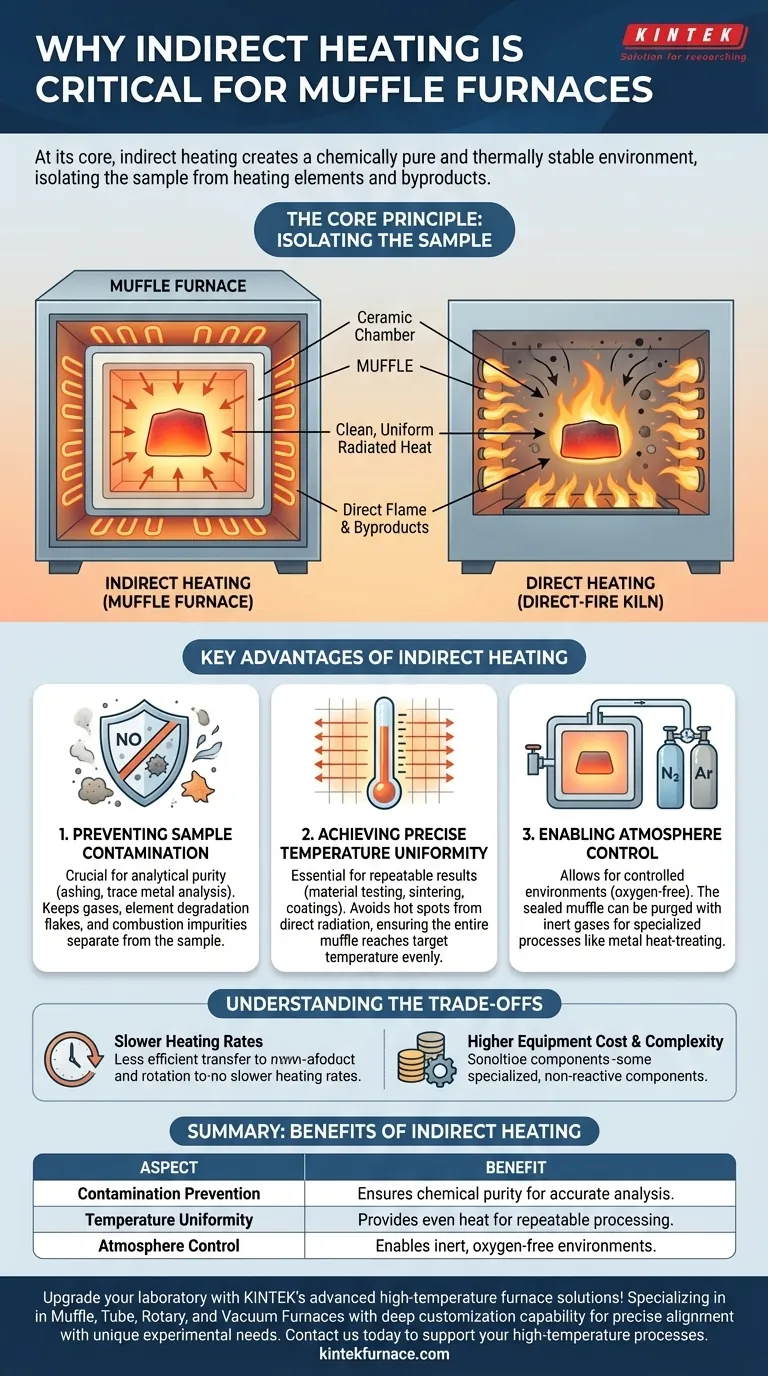At its core, the importance of indirect heating in a muffle furnace is to create a chemically pure and thermally stable environment. By placing the sample inside a "muffle"—a separate, isolated chamber—the heating elements and any combustion byproducts are kept entirely separate from the material being processed. This separation is what enables the precision, purity, and control required for sensitive scientific and industrial applications.
The fundamental purpose of a muffle furnace is not just to heat a sample, but to do so without altering its chemical composition. Indirect heating is the critical design feature that makes this possible by creating an isolated and controllable processing environment.
The Core Principle: Isolating the Sample
The name "muffle furnace" describes its key function. The design is centered around a retort, or muffle, that isolates the workload from the raw energy source.
What is a "Muffle"?
A muffle is a sealed chamber, typically made of high-temperature ceramic or alloy, that sits inside the furnace's insulated shell.
Heating elements are positioned outside this muffle, heating its external walls. The heat then radiates uniformly into the chamber's interior, creating a stable thermal environment for the sample placed inside.
Indirect vs. Direct Heating: A Key Distinction
Think of a muffle furnace like a modern convection oven, where the heating elements are separate from the food. The goal is clean, uniform heat.
A direct-fire kiln or forge, by contrast, is like cooking over an open flame. While effective for raw heating, the flame and its byproducts (like soot or gases) directly interact with the object, which is unacceptable for high-purity work.
Key Advantages of Indirect Heating
This separation of sample from heat source provides three critical advantages that are non-negotiable in many technical fields.
Preventing Sample Contamination
For processes like determining the ash content of a material (ashing) or conducting trace metal analysis, any external contamination invalidates the result.
Indirect heating ensures that gases, flakes from degrading heating elements, or other impurities from the combustion process cannot enter the chamber and alter the sample's mass or chemical makeup.
Achieving Precise Temperature Uniformity
Heating elements inherently have hot spots. By placing them outside the muffle, their direct, uneven radiation does not hit the sample.
Instead, the entire muffle chamber slowly and evenly reaches the target temperature. This thermal uniformity is essential for repeatable material testing, sintering ceramics, and creating consistent coatings, where precise temperature profiles are paramount.
Enabling Atmosphere Control
Because the muffle is a sealed chamber, the atmosphere inside it can be controlled. This is impossible in a direct-fired system.
The chamber can be purged with an inert gas like nitrogen or argon to create an oxygen-free environment. This is crucial for heat-treating metals without oxidation or synthesizing materials that are sensitive to air.
Understanding the Trade-offs
While essential for precision, the indirect heating method comes with practical trade-offs that are important to acknowledge.
Slower Heating Rates
Heating the muffle chamber first, which then radiates heat to the sample, is a less efficient thermal transfer process. This means muffle furnaces typically have slower heat-up and cool-down times compared to direct-fire kilns.
Higher Equipment Cost and Complexity
The inclusion of a high-quality, non-reactive muffle and the systems to control its atmosphere add to the furnace's complexity and overall cost. These are specialized instruments, not simple heating ovens.
Making the Right Choice for Your Goal
Selecting the right furnace depends entirely on the requirements of your process.
- If your primary focus is analytical purity (ashing, composition analysis): The indirect heating of a muffle furnace is mandatory to prevent contamination and ensure accurate results.
- If your primary focus is controlled material processing (annealing metals, sintering ceramics, growing crystals): A muffle furnace is necessary for its precise temperature uniformity and atmosphere control.
- If your primary focus is simple bulk heating (drying, basic heat-treating where oxidation is not a concern): A less expensive, direct-fire oven or kiln may be a more efficient and cost-effective solution.
Ultimately, the use of indirect heating is what elevates a furnace from a simple oven to a precise instrument for scientific discovery and advanced manufacturing.
Summary Table:
| Aspect | Benefit of Indirect Heating |
|---|---|
| Contamination Prevention | Keeps heating elements and byproducts separate from samples, ensuring chemical purity for accurate analysis. |
| Temperature Uniformity | Provides even heat distribution, essential for repeatable material testing and processing. |
| Atmosphere Control | Allows use of inert gases to create oxygen-free environments, preventing oxidation in sensitive applications. |
Upgrade your laboratory with KINTEK's advanced high-temperature furnace solutions! Leveraging exceptional R&D and in-house manufacturing, we offer Muffle, Tube, Rotary Furnaces, Vacuum & Atmosphere Furnaces, and CVD/PECVD Systems. Our strong deep customization capability ensures precise alignment with your unique experimental needs, delivering enhanced purity, control, and efficiency. Don't compromise on quality—contact us today to discuss how we can support your high-temperature processes!
Visual Guide

Related Products
- 1400℃ Muffle Oven Furnace for Laboratory
- Laboratory Muffle Oven Furnace with Bottom Lifting
- 1700℃ High Temperature Muffle Oven Furnace for Laboratory
- 1800℃ High Temperature Muffle Oven Furnace for Laboratory
- Multi Zone Laboratory Quartz Tube Furnace Tubular Furnace
People Also Ask
- What are the main components of a muffle furnace? Key Parts for Precision High-Temp Control
- What are the specifications of a typical muffle furnace? Key Details for Precise High-Temp Control
- What temperature range can muffle furnaces reach? Find Your Ideal Lab Furnace Temperature
- Why is a muffle furnace essential in research laboratories? Unlock Precision Heating for Accurate Results
- What are the key applications of a muffle furnace? Essential for Pure Heat Treatment and Analysis



















